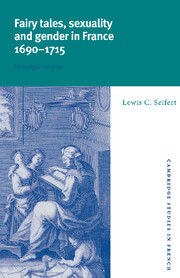Afterword
Published online by Cambridge University Press: 22 September 2009
Summary
Si t'as pas de nostalgie, t'as pas de futur.
Advertising slogan for a Parisian radio station, 1995
Literary history teaches us that forms of romance literature such as the literary fairy tale have been especially attractive in moments of social and cultural transition, a peculiarity that has been explained by these forms' status as a “reinvention of a providential vision” or as a “secular scripture.” At a time of instability and uncertainty, romance offers the stability and certainty alternatively imparted by religious discourses. At moments of tension between competing socio-economic, esthetic, and/or epistemological systems, then, romance mediates a resolution of contradictory and/or irreconcilable desires. And such is the case of the French literary fairy tales published between 1690 and 1715. During a period when an emerging bourgeois consciousness was beginning to compete seriously with a dominant aristocratic ethos, the contes de fées (by and large) projected a worldview that allowed bourgeois and aristocrats alike a retreat into the magnificent wealth of virtuous nobility. As “Ancients” faced off against “Moderns,” literary fairy tales set out to demonstrate the didactic and literary efficacity of a nationally “indigenous” genre. At a time when mondain culture was closely scrutinized by “moralist” critics, the fairy tale unabashedly proclaimed its roots in salon circles, all the while promoting its own moral purpose. At a moment when the discursive groundwork had been laid to exclude women from roles as cultural agents, the vogue proved their ability to fulfill such roles and, indeed, to dominate a literary movement.
- Type
- Chapter
- Information
- Fairy Tales, Sexuality, and Gender in France, 1690–1715Nostalgic Utopias, pp. 220 - 223Publisher: Cambridge University PressPrint publication year: 1996

